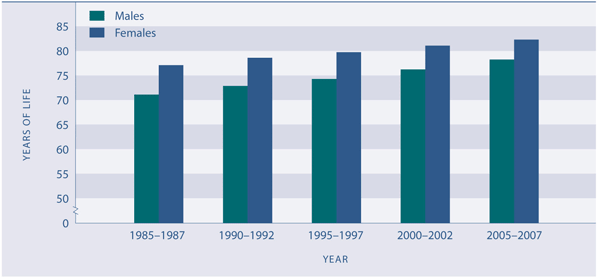Life expectancy
Definition
Life expectancy at birth indicates the total number of years a person could expect to live, based on the mortality rates of the population at each age in a given year or period.
Relevance
Life expectancy at birth is a key summary indicator of fatal health outcomes, ie the survival experience of the population.
Current level and trends
Based on the mortality experiences of New Zealanders in the period 2005–2007, life expectancy at birth was 78.1 years for males and 82.2 years for females. Since the mid-1980s, gains in longevity have been greater for males than for females.
Between 1985–1987 and 2005–2007, life expectancy at birth increased by 7.0 years for males and 5.1 years for females. As a result, the sex gap in life expectancy narrowed from 6.0 years to 4.1 years over this period.
With the decline in the infant mortality rate (from 11.2 deaths per 1,000 live births in 1986 to 4.9 per 1,000 in 2007), the impact of infant death on life expectancy has lessened. The gains in life expectancy since the mid-1980s can be attributed mainly to reduced mortality in the middle-aged and older age groups (45–84 years).
Figure H2.1 Life expectancy at birth, by sex, selected years, 1985–1987 to 2005–2007

Source: Statistics New Zealand
Note: Abridged life table data has been used 2005–2007
Ethnic differences
There are marked ethnic differences in life expectancy. In 2000–2002, male life expectancy at birth was 77.2 years for non-Māori and 69.0 years for Māori, a difference of 8.2 years. Female life expectancy at birth was 81.9 years for non-Māori and 73.2 years for Māori, a difference of 8.8 years.
The pace of improvement in life expectancy has varied by ethnic group. For non-Māori, there was a fairly steady increase in life expectancy at birth over the period from 1985–1987 to 2000–2002, with males gaining 5.8 years and females 4.5 years. For Māori, there was little change during the 1980s, but a dramatic improvement in the five years to 2000–2002. While the gain in Māori life expectancy over the whole period 1985–1987 to 2000–2002 (4.1 years for males, 2.7 years for females) was less than that for non-Māori, Māori gained more than non-Māori in the latter five-year period. As a result, the gap in life expectancy at birth between non-Māori and Māori, which widened by 2.4 years between 1985–1987 and 1995–1997, reduced by 0.6 years in the five years to 2000–2002.
Figure H2.2 Life expectancy at birth, by ethnic group and sex, 1950–1952 to 2000–2002

Sources: Statistics New Zealand; Ministry of Health
Note: Ministry of Health data has been used for 1980–1982 to 1995–1997. It includes an adjustment for the undercount of Mā ori deaths relative to the Māori population by linking mortality to census records
Socio-economic differences
There is an association between life expectancy and the level of deprivation in the area where people live. In 2000–2002, males in the least deprived 10th of small areas in New Zealand could expect to live 8.9 years longer than males in the most deprived 10th of small areas (79.9 versus 71.0 years). For females, the difference was smaller, but still substantial, at 6.6 years (83.8 versus 77.2 years). These figures illustrate the links between socio-economic status and health.21
International comparison
In 2005–2006, New Zealanders’ life expectancy at birth was 81.9 years for females and 77.9 years for males. This was slightly below the OECD median of 82.3 years for females and slightly above the OECD median of 77.1 years for males. Out of 30 OECD countries, New Zealand was ranked 19th equal, with the Netherlands and Luxembourg, for females, and eighth for males. In 1960–1961, New Zealand’s ranking was ninth for females and seventh equal for males. Over the 1970s and 1980s, longevity improved faster in many other OECD countries than in New Zealand. Since the early-1990s, faster-than-average gains in life expectancy in New Zealand, particularly for males, have improved its relative position.
In 2006, life expectancy at birth was highest for females in Japan (85.8 years) and highest for males in Iceland (79.4 years). Compared to New Zealand, female life expectancy was higher in Australia (83.5 years) and Canada (82.7 years in 2005), but lower in the United Kingdom (81.1 years in 2005) and the United States (80.4 years in 2005). Male life expectancy was higher in Australia (78.7 years), similar in Canada (78.0 years in 2005), and lower in the United Kingdom (77.1 years in 2005) and the United States (75.2 years in 2005).22
|


